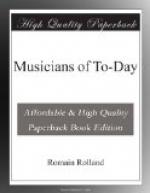On this subject he says:
“Where shall we find the quickening life that will give us fresh forms and formulas? The source is not really difficult to discover. Do not let us seek it anywhere but in the decorative art of the plain-song singers, in the architectural art of the age of Palestrina, and in the expressive art of the great Italians of the seventeenth century. It is there, and there alone, that we shall find melodic craft, rhythmic cadences, and a harmonic magnificence that is really new—if our modern spirit can only learn how to absorb their nutritious essence. And so I prescribe for all pupils in the School the careful study of classic forms, because they alone are able to give the elements of a new life to our music, which will be founded on principles that are sane, solid, and trustworthy."[230]
[Footnote 230: Tribune de Saint-Gervais, November, 1900.]
This fine and intelligent eclecticism was likely to develop a critical spirit, but was rather less adapted to form original personalities. In any case, however, it was excellent discipline in the formation of musical taste; and, in truth, the Ecole Superieure de musique of the Rue Saint-Jacques became a new Conservatoire, both more modern and more learned than the old Conservatoire, and freer, and yet less free, because more self-satisfied. The school developed very quickly. From having twenty-one pupils in 1896, it had three hundred and twenty in 1908. Eminent musicians and professors learned in the history and science of music taught there, and M. d’Indy himself took the Composition classes.[231] And in its short career the Schola may already be credited with the training of young composers, such as MM. Roussel, Deodat de Severac, Gustave Bret, Labey, Samazeuilh, R. de Castera, Serieyx, Alquier, Coindreau, Estienne, Le Flem, and Groz; and to these may be added M. d’Indy’s private pupils, Witkowski, and one of the foremost of modern composers, Alberic Magnard.
[Footnote 231: There are actually nine courses of Composition at the Schola—five for men and four for women. M. d’Indy takes eight of them, as well as a mixed class for orchestra.]
Outside the influence that the School exercises by its teaching, its propaganda by means of concerts and publications is very active. From its foundation up to 1904 it had given two hundred performances in one hundred and thirty provincial towns; more than one hundred and fifty concerts in Paris, of which fifty were of orchestral and choral music, sixty of organ music, and forty of chamber-music. These concerts have been well attended by enthusiastic and appreciative audiences, and have been a school for public taste. One does not look for perfect execution there,[232] but for intelligent interpretations and a thirst for a fuller knowledge of the great works of the past. They have revived Monteverde’s Orfeo and his Incoronazione di Poppea,




